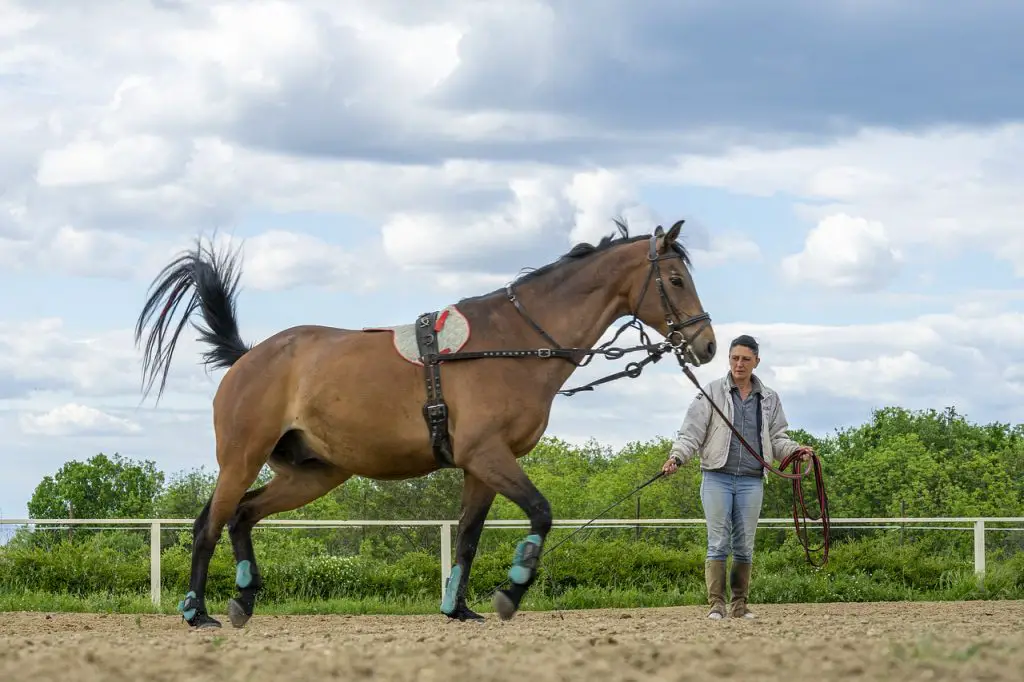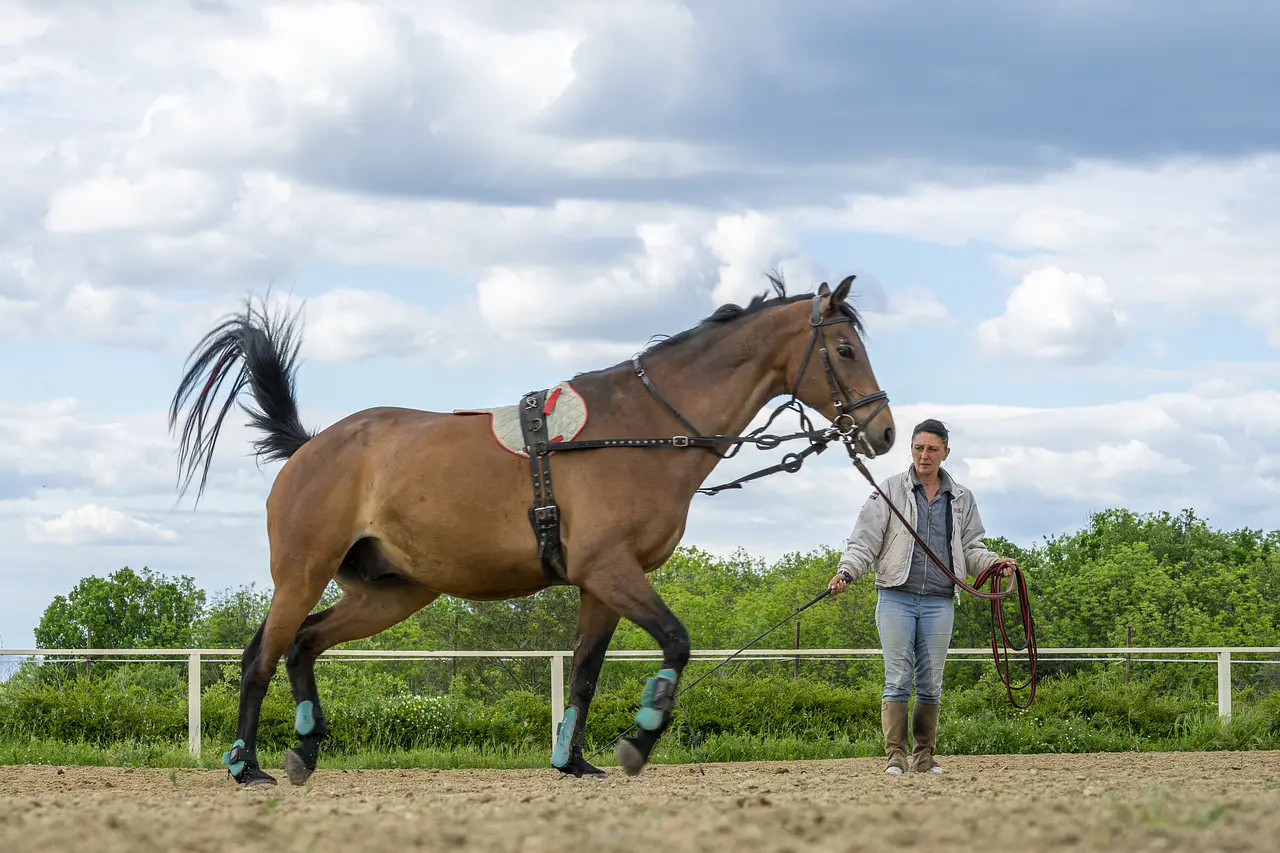Last Updated on March 8, 2022 by Allison Price
You will be amazed at the abilities of these horses and their trainers if you have ever seen them on TV or at shows. Many liberty trainers can work multiple horses together, performing amazing routines and tricks without the use of a saddle or harness. The good news is that anyone can learn liberty horse training. Liberty horse training can be a wonderful tool to train novice riders and horses. Training horses with liberty can foster a strong bond between trainer and horse. Are you looking to be free with your horse? Are you looking for a great liberty horse trainer in your area? What is liberty horse training? Where can you find liberty horse-training exercises?
Let’s take an in-depth look at this natural method of training and how to get started with liberty horse training.
What Is Liberty Horse Training
Liberty horse training is exactly what its name suggests – it allows your horse to roam freely and has no restrictions. This training is done in a large riding paddock or arena. You can let your horse move freely, and you will be able to communicate with your horse.
Professional liberty horse trainers will train their horses in tricks and movements such as bowing, rearing, bowing and pirouettes. All of this can be done without the use of tack or any other aids.
Liberty work is a wonderful way to get to know the horse and uses their natural instincts and behaviors as the primary teaching tool. The liberty training allows the horse to move and leave without any tack or lines. Here is the “liberty” part. The horse cooperates because they want to and not because we force them to.

Liberty training and natural horsemanship often go hand in hand. Both methods understand and use horses’ natural instincts to help them. The trainer can also build a strong relationship with the horse. This allows the horse to express his natural instincts.
For those who are familiar with traditional methods of training, this can seem like a big leap of faith. How can we get our horses behave if they are free? Liberty training is a way to take your horsemanship skills to the next stage. The trainer should not rely on force but be someone that the horse wants to follow and choose to go with, without artificial aids like tack or lines.
How is this possible? A liberty horse trainer will help you understand your horse’s natural instincts, behavior, and how to build a stronger bond.
To earn trust and friendship from the horse, the trainer must first imitate the behavior of horses. The trainer can then become the natural leader of his horse by mimicking the behavior of horses. This creates a strong partnership and connection using the unspoken principles of equine body communication.
How to Start Liberty Horse Training
Learning is the first step towards horse training.
- Learn about natural horse behavior
- Understanding yourself and your emotions
- Get to know your horse’s personality, likes and dislikes
- Learn about natural liberty horse training methods
First, you must be able to work with your liberty horse trainers. You can spend some time with your horse and just be with them. This is a time to observe and learn how your horse interacts first with other horses, then you can start to form a relationship with the herd.
It is essential to understand your horse’s body language, cues, and how to encourage desired traits and behavior. Positive reinforcement is a method where horses are given a reward for choosing the right option. This could be a treat or scratch, or just a kind word. You can also use negative reinforcement methods that apply constant pressure until the horse makes the right choice. You both should have fun and make the training session positive.
There are many ways to work with horses in liberty. Some trainers prefer to begin in a smaller area, such as a pen or round pen. This allows for less distractions. Some trainers will start horses in large fields or arenas right away. A majority of trainers recommend that the horse be trained in a large arena or field with a halter, lead and groundwork.
No matter what your preferred method, the goal remains the same: your horse must decide that hanging out at your place is his favorite!
Liberty Horse Training for Beginners
Liberty horse training is open to all – you don’t need to be a professional trainer to use it! Because they don’t have to change their ingrained horse training habits, novice and beginner riders are more likely to succeed than experienced owners. It is best to look at your horse with new eyes and learn together.
Liberty horse training is open to all, as it doesn’t require any special equipment or facilities. This training method does not require a special area or a round pen. It can be done anywhere your horse is allowed to move freely without restriction. The area must be safe, otherwise your horse could just make a run for it and vanish over the horizon.
You will need to spend some time with your horse before you can begin liberty horse training. You can simply sit down, relax, and let the natural behavior unfold in front of you. This is one of the most valuable training sessions you’ll ever have. Many of us have never had the opportunity to spend time with horses. It can be difficult to learn to be comfortable with your horse’s company and do nothing.
Liberty Horse Training Exercises
You’ve watched your horse in action and hopefully gained some insight into their personalities. What’s the next step?
It can be difficult to know where to begin liberty horse training. We all want to dance, but how do you get there? Let’s look at basic and advanced liberty horse training techniques:
Horse training at liberty – Groundwork
As a youngster, many horses learn how to walk on a rope and halter. This training is not repeated. Groundwork training is vital for all horses. They will have a better understanding of what to expect under saddle if they learn how we communicate with them on ground.
Groundwork on the halter is a great place to begin. Teach your horse how to move away from pressure and then ask them to let go of your space. If your horse responds to the pressure and does not move away from it, you can take off the halter and let them do what they want. You can encourage your horse to move in different directions, by using pressure in different places.
Walking
The liberty horse exercise begins with the horse on the rope and halter. Once you are comfortable, you can move to loose walking.
It is important to train the horse to walk side by side with the trainer. He shouldn’t stomp ahead, lag behind, or veer off to the side. He should do this because he loves it – aids are there to guide the horse, not force him to.
Begin by walking alongside your horse on loose rope. Slow down and ask your horse to slow down if he is moving ahead. If necessary, a flag can be placed in front of him to create a visual barrier. If he is slow to respond, encourage him with verbal encouragement and a firm body posture.
Turning
When you are able to walk together as a couple, it’s time to begin walking to halt and walking to halt transitions. Start with the halter first – these basic commands are essential to make liberty training safe.
To get your horse to stop and start, use exaggerated versions and verbal cues for walking. These cues can be made more subtle over time until your horse is able to start and stop by a slight alteration in your body posture.
First stop the horse and then turn the horse around. To help the horse understand what you are asking, you can use a flag. After he turns, you can continue walking until he is able to turn without stopping.
It can be difficult to learn how to walk, stop, and turn your horse. However, it is an amazing feeling when your horse can go in any direction you choose without the need for a lead or halter.
Training your Liberty horse
It is not difficult to train liberty horses. It is important to gradually increase your willingness to do this and to use lots of positive reinforcement. Begin by lifting a leg and then applying pressure to the chest to rock your horse forwards and backwards. You can eventually get the horse rocking down to the ground by building up your skills. Once you’ve mastered this, you can begin to teach your horse to bow when given a signal such as a tap on his leg.
Liberty Horse Trainers near Me
Sometimes, we all need some one-to-one support. But how can you find a good trainer for your dance? It can be difficult to find liberty trainers in your area. Word-of-mouth referrals are the best way to begin. You can ask local equestrian shops and facilities for recommendations, or post on local horse groups via social media.
You can also search online liberty horse trainers via Google or other web search engines. You should look for trainers who have positive testimonials and are willing to recommend others. Ideally, you should also be able see the trainer in action. You may not find the right trainer for your horse or rider combination.
You may have to look beyond the local liberty horse trainers if you’re not finding any. You and your liberty horse friend can enjoy a weekend away with many trainers who offer residential training weekends. A weekend of intensive training can help you to build a strong bond with your horse.
Liberty horse training exercises
There are many online resources that can help you and your horse on their liberty training journey.
Our recommended program is Dancing At Liberty, available at www.dancingatliberty.com. This course is suitable for all levels of horse riding, including novices and experienced trainers. Dancing At Liberty will allow you and your horse create a strong bond, which can lead to a successful partnership.
This course is so efficient because it breaks down the liberty horse training process in easy-to-understand steps. It makes training both horses and trainers more enjoyable and fun. Classes start at the beginning with learning how to watch and understand horses. They then move on to creative liberty sessions and dancing together!


